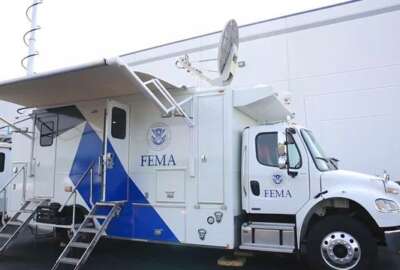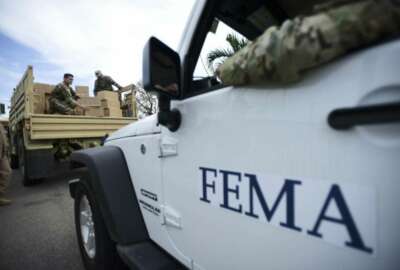

Hubbard Radio Washington DC, LLC. All rights reserved. This website is not intended for users located within the European Economic Area.
The Federal Emergency Management Agency wants to strengthen its frontline workforce, as natural disasters across the country increase in both frequency and severity.
FEMA Administrator Deanne Criswell said she is focused on improving recruitment for the agency’s reservist workforce, which comprises the majority of FEMA’s response force going out to communities to respond to disasters. That’s especially important, she said, as the number of disasters FEMA responds to each year has more than tripled in...
The Federal Emergency Management Agency wants to strengthen its frontline workforce, as natural disasters across the country increase in both frequency and severity.
FEMA Administrator Deanne Criswell said she is focused on improving recruitment for the agency’s reservist workforce, which comprises the majority of FEMA’s response force going out to communities to respond to disasters. That’s especially important, she said, as the number of disasters FEMA responds to each year has more than tripled in the last decade, up from 108 to 349.
“The more tools we have to recruit a really strong reservist workforce will help us increase the number of individuals that we have available, but also the types of technical skills that we need to face the types of disasters that we are starting to see,” Criswell told senators at a June 22 hearing for the Homeland Security and Governmental Affairs Committee.
To better recruit and support reservist workers as disasters intensify, FEMA added multiple programs focused on improving the mental health of its workforce. The White House’s fiscal 2023 budget request would continue to fund those programs, Criswell said. The budget request contains additional initiatives to support and strengthen FEMA’s workforce, including $6.4 million for the incident management workforce.
“The unrelenting pace of a year-round cycle of disasters and crises places great demands on the FEMA team. We must look out for the physical, the emotional and the mental health of our workforce,” Criswell said.
That comes as the agency struggles with staffing shortages, which the Government Accountability Office said makes disaster response all the more difficult.
Criswell said along with helping agency workers, she wants to ensure FEMA has the right balance of employees to respond to what has become a year-long disaster response pace. At a House hearing for the Homeland Security Committee’s Emergency Preparedness subcommittee, Criswell said FEMA is looking at ways to increase its services without placing additional strain on the agency’s staff.
“We are taking a look right now at taking a step back, now that we have more of this year-long operational tempo instead of the peak that we have traditionally seen during hurricane season, of what does the future staffing model need to look like,” Criswell said at the June 14 hearing. “We’re doing a deep dive into that analysis so we can better plan and appropriate our staff for a year-long response as we continue to go forward.”
To provide better response efforts to underserved communities, FEMA’s strategic plan for fiscal 2022 through 2026 additionally incorporates diversity, equity, inclusion and accessibility priorities. And a significant part of the agency’s DEIA efforts are internally facing.
“Through investment in diversity and inclusion efforts — including employee resource groups and multicultural training — FEMA can increase its employees’ involvement and participation in cultivating a culture of inclusion. Additionally, leaders and managers must be leveraged to promote equity practices, transparency, and accountability across the agency,” the strategic plan stated.
“The more our workforce resembles the nation we serve, the better we will serve it,” Criswell said at the HSGAC hearing. “We are adapting our recruiting efforts to reach individuals from underrepresented communities by partnering with organizations like historically black colleges and universities, as well as other minority-serving institutions.”
To measure DEIA improvements to its workforce, FEMA will use the Federal Employee Viewpoint Survey to analyze the results of questions on diversity, equity and inclusion, the strategic plan said.
One HSGAC committee member, though, questioned FEMA’s focus on equity initiatives during the hearing. Sen. Josh Hawley (R-Mo.) said he was concerned that the agency’s DEIA focus would take away from its ability to respond to disasters.
Criswell said in response that FEMA’s strategic plan emphasizes improving equity to better understand how individual communities experience disasters differently, and how the agency can build internal equity to better respond to disasters in underserved communities.
“[Of] each of the objectives within my priorities, one focuses externally on how we deliver our services to communities, one focuses internally on how our workforce is going to support that and another one talks about how we partner with other stakeholders in order to deliver our programs,” she said.
On Capitol Hill, some legislation is also looking to improve equity at the agency. Under a bill from Sen. Gary Peters (D-Mich.), HSGAC’s chairman, FEMA would establish a new office dedicated to better serving communities who historically receive disproportionately low funds from FEMA during and after disasters.
HSGAC also passed the Civilian Reservist Emergency Workforce, or “CREW” Act, in December, which would extend USERRA protections to FEMA’s reservist workforce. USERRA – or the Uniformed Services Employment and Reemployment Rights Act of 1994 – was originally established for reservist civilian personnel who get called in for military service, to ensure reinstatement of their civilian jobs after completing their service. The CREW Act would extend the same pay and training protections for FEMA reservists.
“What this act will do is give them reemployment protection, which means it will transform the way that we can recruit our reservist workforce, bring in specialties to come in and support those jurisdictions [and] even give us the opportunity to have more reservists that are right in the local community,” Criswell said at the House committee hearing.
“This is a hugely important piece of legislation for our workforce and for FEMA’s mission,” she added.
Drew Friedman is a workforce, pay and benefits reporter for Federal News Network.
Follow @dfriedmanWFED


